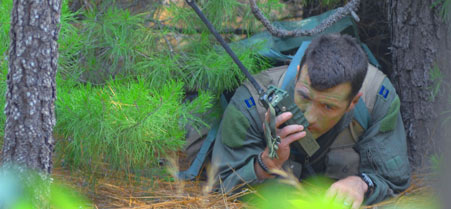Congress takes and gives in funding major Defense IT projects
Hill cuts Air Force's budget for upgrading network infrastructures on bases and for global communications but fully funds radio and UAV programs.
 The Joint Tactical Radio System program will replace radios currently used in the field.
The Joint Tactical Radio System program will replace radios currently used in the field.
The fiscal 2010 Defense appropriations bill signed by President Obama boosted the budgets for some major technology programs while cutting others.
On the losing end was an Air Force program to provide network infrastructure on bases and for global communications, including fiber optic circuits connected to the Defense Information Systems Network. The service sought $425.8 million for the Combat Information Transport System project, but Congress slashed $100 million from that budget request.
Col. Russ Fellers, program manager for the Combat Information Transport System at the Electronic Systems Center at Hanscom Air Force Base, Mass., portrayed the project at an industry briefing in May as key to the service's new mission to defend networks in cyberspace.
But Congress said in the report accompanying the final version of the bill that it cut funding for the program because the Air Force had not spent $127 million from the project's fiscal 2008 budget and had $87.5 million left over from its fiscal 2009 budget. The Air Force awards task orders from its Network-Centric Solutions contract for work on the system, and General Dynamics, Harris Corp. and Telos Corp. have worked on the network.
In addition, the service had requested an increase of $88.6 million in the fiscal 2010 budget to modernize networks at Air Force National Guard bases. Congress directed the service to allocate $100 million from the unexpended funds for the Combat Information Transport System to pay for upgrades at the bases.
Congress was more generous in funding a large radio program managed by the Navy. The Hill approved the service's request of $880 million for the Joint Tactical Radio System, a project the service started in 1996 to replace 750,000 hardware-based radios for backpacks, vehicles, ships and aircraft with 180,000 software-based radios that can operate on multiple frequencies.
Congress acknowledged that the new radios do not meet the needs of a military that is engaged in two wars. In the conference report, members said that while it continues to support the key goals of JTRS, "full testing objectives have not been realized."
While the JTRS program has successfully tested some radios, Congress said, the Hill still encouraged the services to push for competition among different radio platforms, such as the older Single Channel Ground and Airborne Radio System, which is the standard voice radio used by infantry units, and newer commercially developed radios such as the Falcon series, manufactured by Harris Corp. Competition will help bridge the communications gap until JTRS radios are ready for fielding, the report noted.
The report language acknowledges the difficulties Defense encounters with any software-driven project, said Bernie Skoch of Suss Consulting Inc., a retired Air Force general who spent his military career in communications and is an avid ham radio operator. This is compounded in the case of JTRS by coupling software with the challenges of radio frequency engineering, he added.
The Defense bill funded another key communications system, giving $1.8 billion to the fourth communications satellite in the Advanced Extremely High Frequency program. The satellite is manufactured by Lockheed Martin Corp., which provides jam-resistant communications at data rates from 75 bits per second to 8 megabits per second.
As expected, Congress fully funded Defense's request for unmanned aerial vehicles, which the military uses extensively for reconnaissance in Afghanistan and Iraq. Funding included $554 million for Global Hawk UAVs from Northrop Grumman Corp.; $489 million for 24 MQ-9 Reapers and $481 million for 24 MQ-1C Sky Warriors, both manufactured by General Atomics Aeronautical Systems Inc.
NEXT STORY: Defense's Senior Mentor Slush Fund



